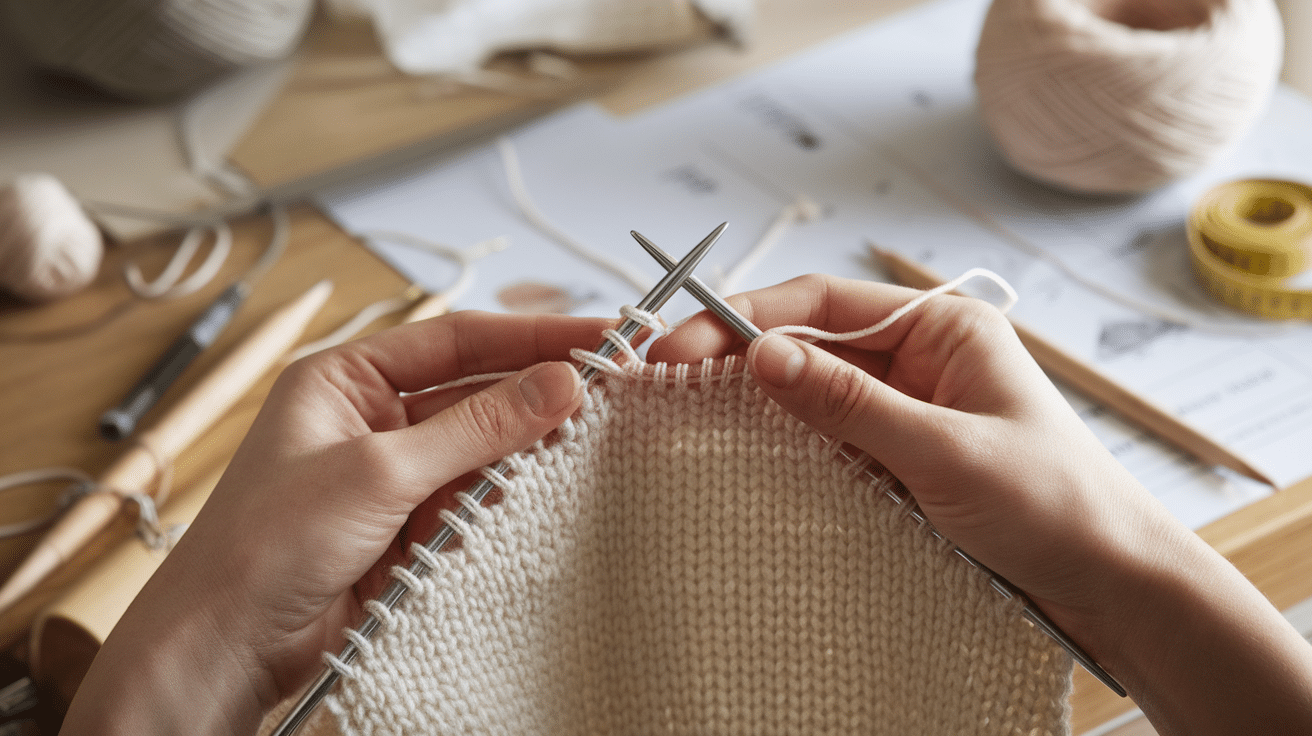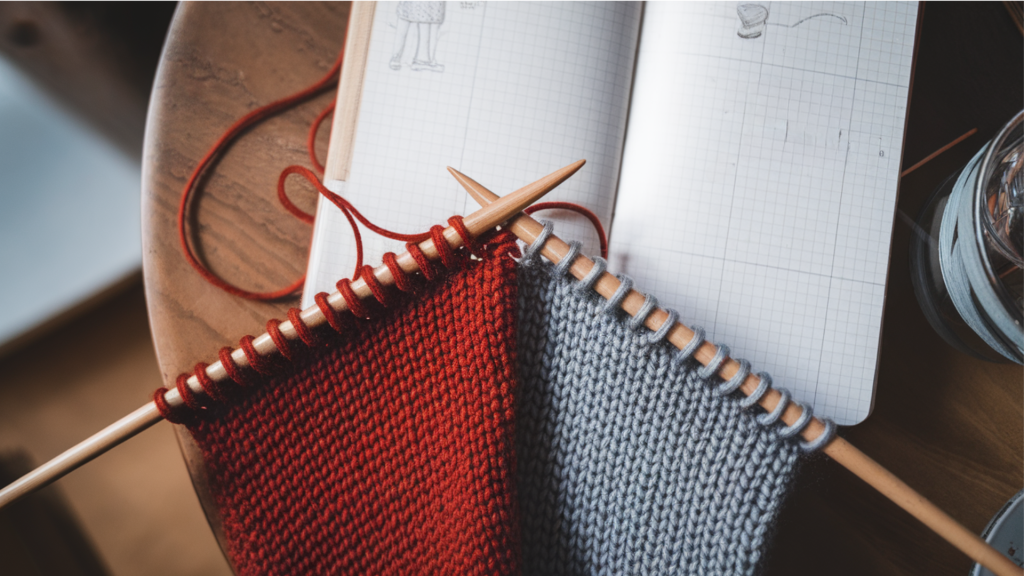Double knitting cast-on creates a strong and balanced edge for projects that need two layers of fabric. This method helps knitters start their work with even stitches, keeping both layers connected from the beginning.
Choosing the right cast-on is important because it affects the edge’s look, stretch, and strength. Some methods create a smooth and stretchy start, while others provide a firm, structured border.
Knitters use double knitting cast-on for scarves, hats, and reversible designs. It keeps edges neat and prevents gaps between layers.
This guide will explain different cast-on techniques, their uses, and how to choose the best one for your project. Understanding these methods allows you to improve your double-knitting skills and create well-structured pieces.
What Is a Double Knitting Cast On?

A double knitting cast-on starts a project with two layers of fabric. It connects both layers right from the beginning and keeps the edge even.
This method uses paired stitches to help each side grow at the same rate. It prevents gaps and keeps one layer from being tighter than the other.
It’s often used for scarves, blankets, hats, and other reversible pieces. The result is a clean, firm edge that stays in place and gives the project a smooth start.
Why Use a Double Knitting Cast On?
A double knitting cast-on gives a strong and even start for projects with two fabric layers. It helps keep tension balanced and avoids loose edges or distortion.
- Creates a sturdy edge: Supports both layers so the fabric doesn’t pull or sag. A tight edge limits stretch, and a loose one may separate the layers.
- Produces a reversible edge: Both sides look the same, making it great for scarves, blankets, and other double-sided projects.
- Maintains even tension: Keeps the fabric from stretching unevenly by balancing stitches from the start.
- Keeps two-color projects aligned: Holds both yarns in place, keeping edges clean and patterns sharp.
- Prevents fabric from stretching unevenly: A steady edge helps the piece hold its shape over time.
This technique improves the quality of double-knitting projects by giving them a polished, balanced foundation.
Types of Double Knitting Cast-On Methods
Different double knitting cast-ons offer different results. Some are better for stretchy edges, while others are best for structure or color design. Choosing the right one depends on the project.
Below are four popular cast-on methods. Each one has its own use, look, and learning curve. Picking the right method can help you avoid tension issues and improve your final result.
1. Invisible Cast On
This method creates a soft, stretchy edge that blends into the fabric. It works well for reversible pieces like scarves or blankets where both sides need to look the same.
It takes practice to control the tension, but the finish is smooth and flexible. The stitches are made in pairs, and both yarns are used from the start.
2. Alternating Two-Color Cast On
This method creates a clear edge that shows both yarn colors. It’s good for borders or bold designs that highlight contrast between stitches.
You alternate colors as you cast on, creating a firm and structured edge. It’s best for projects like potholders or scarves where the border should stand out.
3. Standard Long Tail Cast in One Color
This method is easy for beginners. You cast on using just one yarn, then add the second color when you begin the next row of knitting.
It doesn’t create a reversible edge, but it’s a good starting point. It works well for blankets or garments that only show one side.
4. Casting on For Two-At-A-Time Knitting
This method is useful when making matching items like mittens or socks. You cast on half the stitches in each color and move them onto one needle.
It helps make both pieces evenly, saving time and improving symmetry. It’s perfect for paired projects that need to match in shape and size.
Choosing the Right Cast-On for Your Project
Selecting the right cast-on method for double knitting depends on the type of project, the degree of flexibility needed for the edge, and the final appearance.
Some projects require a stretchy edge, while others benefit from a firmer, more structured start. Here are some factors to consider when choosing a double knitting cast-on.
1. Stretchy vs. Firm Edge
If the project needs a flexible edge, such as for hats, scarves, or reversible garments, a stretchy cast-on like the invisible method works best.
For potholders, decorative panels, or structured pieces, a firmer cast-on, such as the alternating two-color method, provides a stronger edge. Choosing the right approach ensures the finished piece holds its shape and functions well.
2. Seamless Look vs. Defined Border
Some cast-on methods, like the invisible cast-on, blend into the fabric, making them ideal for reversible projects. Others, like the alternating two-color cast-on, create a distinct edge that highlights the colors in the design.
A seamless method is best if the goal is a smooth transition from edge to fabric. A structured cast-on is a better option if a bold, well-defined border is preferred.
3. Matching Bind-Off
The cast-on method should complement the bind-off to create a balanced look. If the project has an invisible cast-on, using a matching invisible bind-off ensures that both edges look the same.
A firmer cast-on, such as the two-color method, works well with a structured bind-off that keeps the border even and prevents curling. Matching the cast-on and bind-off helps maintain symmetry in the final piece.
Common Mistakes and How to Avoid Them
Even with good technique, it’s easy to run into small issues while casting on for double knitting. If not fixed early, these problems can affect the look and balance of your project.
- Uneven tension: If one side is tighter than the other, the fabric can curl or stretch unevenly. Hold both yarns evenly and practice on scrap yarn to keep tension steady.
- Misaligned color placement: Stitch pairs must match to keep colors in the right order. Check each pair as you go, and use stitch markers or notes to stay on track.
- Stitches too tight or loose: If the stitches are too tight, the edge won’t stretch. If too loose, it may look messy. Keep the stitches snug but loose enough to move on the needle.
Watching out for these issues will help you get clean edges and an even start, leading to a stronger and more polished project.
Matching Bind-Off Techniques
Choosing the right bind-off keeps your double-knitting project looking neat and even. It helps both layers stay balanced and makes sure the edge doesn’t curl or stretch too much.
The best method depends on your cast-on and how flexible or firm you want the edge to be. Here are three common options and how to use them.
1. Invisible Bind-Off
It works well with an invisible cast-on and gives a stretchy, smooth edge to reversible pieces like scarves and blankets.
Here’s how to do it:
- Knit and purl the first two stitches as they appear.
- Insert the left needle into the first stitch and pass it over the second.
- Continue the same pass-over step for each stitch.
- Keep your tension loose so the edge can stretch.
- Weave in the yarn tail when done.
This method gives a soft, clean edge that blends into the fabric on both sides.
2. Two-Color Bind-Off
Best for projects with a bold, two-color edge. It keeps both colors visible and the finish firm.
Here’s how to do it:
- Knit the first stitch in one color, then the next in the second color.
- Pass the first stitch over the second to bind off.
- Keep switching colors as you bind off.
- Hold steady tension for an even finish.
- Weave in both yarn tails when done.
It creates a colorful edge that matches two-tone cast-ons and keeps the border strong.
3. Basic Double Knitting Bind-Off
This is a simple method that works with most double-knitting projects. It is great for firm edges that don’t need much stretch.
Here’s how to do it:
- Knit the first two stitches together as one.
- Pass the first stitch over the second.
- Knit the next stitch, then pass the previous stitch over it.
- Repeat until one stitch remains.
- Cut the yarn and pull it through the last stitch.
This bind-off is clean, easy, and perfect for beginners or any project with a structured edge.
Why Every Knitter Should Learn This Technique
Learning the double knitting cast-on gives your project a clean and strong start. It helps shape your work from the first row and makes the whole piece look neat and even.
- Creates a durable and balanced edge: It holds both fabric layers together and keeps the edges from stretching or shifting.
- Improves symmetry in double knitting projects: The fabric grows evenly on both sides, giving it a smooth and finished look.
- Provides better control over fabric tension: It helps keep both sides equal, so your stitches stay balanced as you work.
Using this technique makes your knitting more solid and polished. It’s a simple way to level up your skills and get better results in every project.
Other Helpful Knitting Techniques
Learning the double knitting cast-on is just one step. Other techniques help keep your fabric even, strong, and the right size throughout your project.
- Double knitting increase and decrease methods: These help shape items like socks, mittens, and sweaters while keeping both layers connected.
- Gauge considerations for double knitting: Since you’re working two layers at once, checking your gauge helps the project fit well and keeps the fabric from being too loose or tight.
- Best yarn choices for double knitting: Smooth, stretchy yarns help keep tension even and make it easier to handle two strands at once.
Using the right tools and methods can make a big difference in how your final piece looks and feels.
Conclusion
Knitters can improve their skills by learning these techniques and creating polished, professional-looking double-knitting projects.
Learning the double knitting cast-on is an important step for knitters who want to create smooth, strong edges. This method keeps stitches even, prevents gaps between layers, and improves the overall structure of double-knit projects.
Choosing the right cast-on technique helps set the foundation for proper tension and flexibility. Some methods create a seamless edge, while others provide a bold, structured border. Selecting the best approach ensures the project has a well-balanced start.
Matching the bind-off to the cast-on also helps maintain symmetry. A well-matched edge prevents curling and gives both sides a polished look.
By practicing these techniques, knitters can improve their skills and create high-quality double-knitting projects with a clean and professional finish.
Frequently Asked Questions
Which Cast-On Method Is Best for Beginners?
The standard one-color long-tail cast-on is the simplest for beginners. It allows knitters to start double knitting with a single color before introducing a second yarn.
How Do I Keep My Tension Even While Casting On?
Maintain a steady grip on both yarns and avoid pulling too tightly or too loosely. Practicing on scrap yarn can help develop a smooth and consistent rhythm.
What if My Cast-On Edge Is Too Tight?
Use a larger needle for the cast-on row, or adjust your grip to loosen the stitches slightly. Keeping the yarn relaxed while forming stitches helps maintain flexibility.
How Do I Choose the Right Bind-Off for My Project?
Match the bind-off to your cast-on for consistency. An invisible bind-off works well with an invisible cast-on, while a two-color bind-off complements a bold, structured edge.









